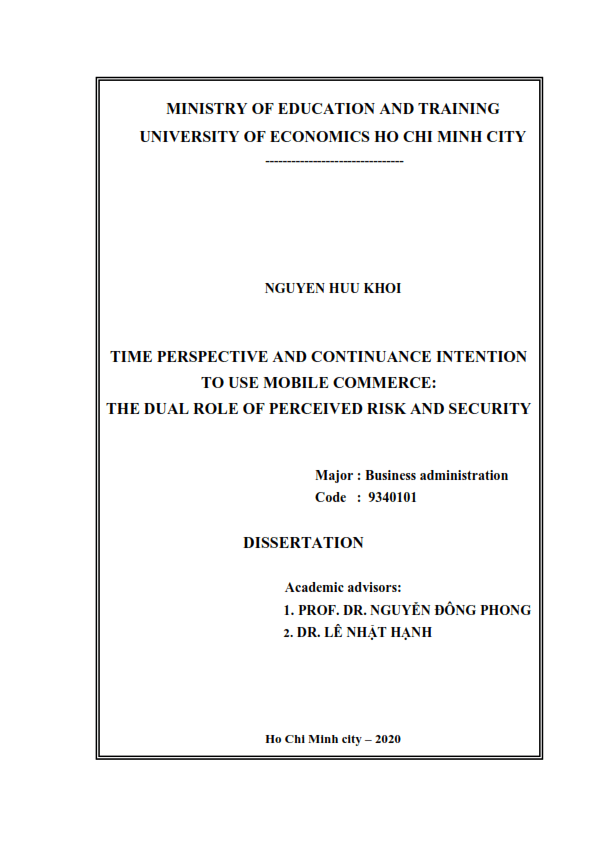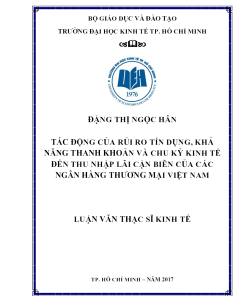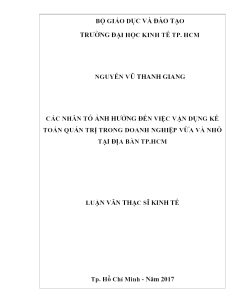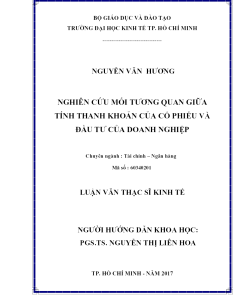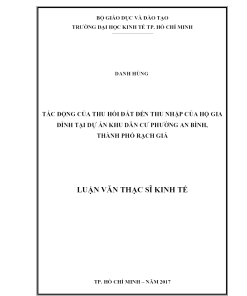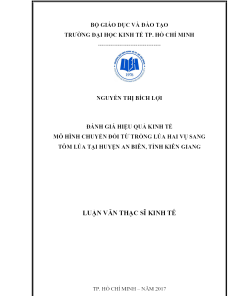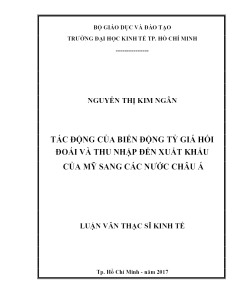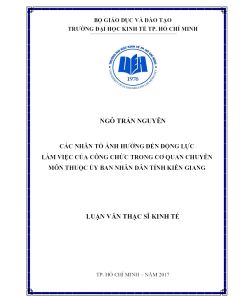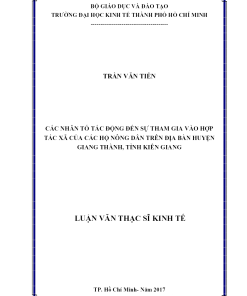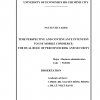Download Thesis Business administration: Time perspective and continuance intention to use mobile commerce: The dual role of perceived risk and security (LA08.079)
This study investigates how a specific domain consideration of future consequences i.e., consideration of future consequences-Immediate (CFCImmediate) and consideration of future consequences-Future (CFC-Future) asymmetrically associate and interact with perceived risk and perceived security as trade-off constructs in predicting continuance intention to use mobile commerce.
Based on a self-administered survey data set of 441 Vietnamese consumers, partial least square structural equation modeling is used to test the hypotheses. The results show that CFC-Immediate and CFC-Future are important in explaining continuance intention to use mobile commerce, but their roles are different due to the asymmetric impact on perceived risk versus perceived security as well as their moderating effects on the perceived risk, security and continuance intention.
This study is unique since it explores the different roles of CFC-Immediate and CFC-Future in explaining continuance intention to use mobile commerce under the trade-off role of perceived risk versus perceived security.
Keywords: Consideration of future consequences; perceived risk and security; continuance intention; direct, asymmetric and moderating effects.
Luận án này nghiên cứu cách thức biến số xem xét kết quả trong tương lai trong bối cảnh thương mại di động, cụ thể hơn là xem xét kết quả tương lai trong ngắn hạn (CFC-Immediate) và xem xét kết quả tương lại trong dài hạn (CFC-Future) tác động bất đối xứng đến rủi ro cảm nhận và an toàn cảm nhận cũng như tương tác với các biến số này trong việc dự báo ý định tiếp tục sử dụng thương mại di động.
Dựa trên một mẫu khảo sát tự quản lý gồm 441 người tiêu dùng Việt Nam, phương pháp mô hình cấu trúc tối thiểu bán phần được sử dụng để kiểm định giả thuyết. Kết quả cho thấy CFC-Immediate và CFC-Future có vài trò quan trọng trong việc giải thích ý định tiếp tục sử dụng thương mại di động, nhưng vai trò mỗi biến số là khác nhau do tác động bất đối xứng đến đến rủi ro cảm nhận và an toàn cảm nhận cũng tác động điều tiết lên mối quan hệ giữa rủi ro cảm nhận, an toàn cảm nhận và ý định tiếp tục sử dụng thương mại di động.
Luận án có những đóng góp quan trọng trong việc khám phá tác động của CFC-Immediate và CFC-Future đến ý định tiếp tục sử dụng thương mại di động dưới sự đánh đổi về cảm nhận giữa của rủi ro cảm nhận và an toàn cảm nhận.
Từ khóa: Xem xét kết quả trong tương lai; rủi ro cảm nhận và an toàn cảm nhận; ý định tiếp tục; tác động trực tiếp, bất đối xứng và điều tiết.
LA08.079_Time perspective and continuance intention to use mobile commerce: The dual role of perceived risk and security
iii
TABLE OF CONTENT
Declaration of authenticity .......................................................................................... i Acknowledgments...................................................................................................... ii Table of content......................................................................................................... iii List of abbreviations.................................................................................................. vi List of tables ............................................................................................................. vii List of figures .......................................................................................................... viii Abstract ..................................................................................................................... ix CHAPTER 1 - INTRODUCTION ..............................................................................1
1.1. Definition of key terms............................................................................1
1.2. Research background ..............................................................................3
1.2.1. Time perspective and consideration of future consequences ...............3
1.2.2. Research gap.........................................................................................4
1.2.3. Mobile commerce adoption in Vietnamese enterprises .......................7
1.2.4. The selection of Vietnam as a research context for the current study12
1.3. Justification for the current research .....................................................14
1.4. Research objectives and research questions..........................................18
1.5. Research methodology and scope .........................................................19
1.6. Research contributions ..........................................................................20
1.7. Research structure .................................................................................21
1.8. Research limitations ..............................................................................22
1.9. Summary ...............................................................................................22
CHAPTER 2 - LITERATURE REVIEW .................................................................24
2.1. Mobile commerce and its advantages ...................................................24
2.2. Continuance intention to use mobile commerce ...................................27
2.3. Previous studies on mobile commerce ..................................................29
2.3.1. Previous studies on mobile commerce context in a Vietnam context29
2.3.2. Previous studies on mobile commerce in an international context ....37
iv
2.3.3. Individual difference variables in mobile commerce research and consideration of future consequences ...................................................................46
2.3.4. Perceived risk and perceived security in mobile service adoption ....49
2.4. Conclusion of the literature review .......................................................51
2.5. Summary ...............................................................................................52
CHAPTER 3 - HYPOTHESES DEVELOPMENT ..................................................53
3.1. Theoretical frameworks to connect consideration of future consequences, perceived risk and security and continuance intention to use mobile commerce .53
3.1.1. Regulatory focus theory .....................................................................53
3.1.2. Regulatory fit theory ..........................................................................55
3.2. Research hypotheses and research model .............................................57
3.2.1. Consideration of future consequences-Immediate versus consideration of future consequences-Future ..............................................................................57
3.2.2. Perceived risk vs security and continuance intention to adopt mobile commerce .......................................................................................................58
3.2.3. The relationships between time perspective and perceived risk versus perceived security..................................................................................................62
3.2.4. The moderating effects of CFCs ........................................................64
3.2.5. Proposed research model and hypotheses ..........................................66
3.3. Summary ...............................................................................................68
CHAPTER 4 - RESEARCH METHODOLOGY .....................................................69
4.1. Research process ...................................................................................69
4.2. Pilot study..............................................................................................75
4.2.1. Questionnaire design ..........................................................................75
4.2.2. Cronbach’s Alpha testing results........................................................80
4.3. The main study ......................................................................................90
4.3.1. Data collection....................................................................................90
4.3.2. Data analysis method..........................................................................93
4.4. Summary ...............................................................................................96
v
CHAPTER 5 - RESULTS AND DISCUSSION.......................................................98
5.1. Validation of measures: reliability and validity ....................................98
5.1.1. First-order and reflective – reflective second-order constructs..........98
5.1.2. Reflective - formative second-order construct .................................107
5.2. Checking for common method bias ....................................................108
5.3. The strategy for testing the proposed moderating effects ...................109
5.3.1. Product indicator approach...............................................................109
5.3.2. Orthogonalizing approach ................................................................109
5.3.3. Two-stage approach .........................................................................110
5.3.4. Justification for selecting the two-state approach ............................111
5.4. Testing hypotheses by applying PLS-SEM.........................................111
5.4.1. Research model quality ....................................................................112
5.4.2. The direct effects ..............................................................................112
5.4.3. The moderating effects .....................................................................113
5.4.4. Testing for asymmetric impact.........................................................114
5.4.5. Post-hoc analysis ..............................................................................115
5.4.6. The summarization of hypothesis testing results .............................116
5.5. Hypothesis testing results summary ....................................................118
5.6. Discussion ...........................................................................................120
5.7. Summary .............................................................................................123
CHAPTER 6 - CONCLUSIONS ............................................................................124
6.1. Conclusion...........................................................................................124
6.2. Theoretical implications ......................................................................125
6.3. Practical implications ..........................................................................130
6.4. Limitations and future research ...........................................................132
6.5. Summary .............................................................................................134
List of author’s published papers ................................................................................1
REFERENCES............................................................................................................3
APPENDICES...........................................................................................................29
vi
LIST OF ABBREVIATIONS
CFC Consideration of future consequences
CFC-Future Consideration of future consequences - Future CFC-Immediate Consideration of future consequences - Immediate CMB Common method bias
DTPB Decomposed Theory of Planned Behavior
EC Electronic commerce
IDT Innovation diffusion theory
MC Mobile commerce
MISS Information systems success
PLS-SEM Partial least square structural equation modeling
SCT Social cognitive theory
PR Perceived risk
PS Perceived security
TAM Technology acceptance model
TTF Task – technology fit
TPB Theory of planned behavior
TRA Theory of reasoned action
UTAUT The unified theory of acceptance and use of technology
The extended unified theory of acceptance and use of
UTAUT2
technology
VIF Variance inflation factor
vii
LIST OF TABLES
Table 1-1: Definition of key terms used in the present research ................................1
Table 2-1: Mobile commerce advantages over electronic commerce ......................25
Table 2-2: Previous studies on mobile commerce in a Vietnam context..................30
Table 2-3: Some widely adopted theories of adoption .............................................38
Table 3-1: The summary of regulatory focus theory ................................................54
Table 3-2: Summarization of proposed hypotheses ..................................................66
Table 4-1: Constructs measurement..........................................................................75
Table 4-2: Cronbach's Alpha testing results .............................................................80
Table 4-3: Final items of the questionnaire ..............................................................86
Table 4-4: Respondents' characteristic......................................................................93
Table 5-1: Cronbach's Alpha and composite reliability............................................99
Table 5-2: Factor loadings and average variance extracted ....................................100
Table 5-3: Fornell-Larcker and Heterotrait-Monotrait criterion.............................106
Table 5-4: Convergent testing results of reflective-formative second-order construct
.................................................................................................................................108
Table 5-5: The direct effect testing results..............................................................112
Table 5-6: The moderating effect testing results ....................................................113
Table 5-7: Testing the relative importance of direct effects ...................................114
Table 5-8: ANOVA analysis results .......................................................................115
Table 5-9: Summary of path analysis testing results ..............................................117
Table 5-10: Summary of hypothesis testing results ................................................118
viii
LIST OF FIGURES
Figure 1-1: Websites with a mobile version ...............................................................9
Figure 1-2: Enterprises with a mobile application for doing business........................9
Figure 1-3: Average time-on-site of customers on the mobile versions of websites10
Figure 1-4: Percentage of enterprises with a mobile application to support.............10
Figure 1-5: Forms of advertising on websites/mobile applications ..........................11
Figure 1-6: Advertising expenditure of the five cities ..............................................11
Figure 1-7: Evaluation of the effectiveness of online advertising forms..................12
Figure 2-1: Comparison between mobile commerce and other types of commerce.25
Figure 3-1: Regulatory fit between individual focus and risk vs security perception
...................................................................................................................................56
Figure 3-2: Conceptual model of consideration of future consequences..................57
Figure 3-3: Proposed research model........................................................................68
Figure 4-1: Research process diagram ......................................................................73
Figure 5-1: The reflective - reflective second-order construct of perceived risk ...107
Figure 5-2: The reflective - formative second-order construct of perceived security
.................................................................................................................................107
Figure 5-3: Path analysis results (without lower-order constructs) ........................119
Figure 5-4: Path analysis results (with lower-order constructs) .............................120
ix
ABSTRACT
This study investigates how a specific domain consideration of future consequences i.e., consideration of future consequences-Immediate (CFC- Immediate) and consideration of future consequences-Future (CFC-Future) asymmetrically associate and interact with perceived risk and perceived security as trade-off constructs in predicting continuance intention to use mobile commerce. Based on a self-administered survey data set of 441 Vietnamese consumers, partial least square structural equation modeling is used to test the hypotheses. The results show that CFC-Immediate and CFC-Future are important in explaining continuance intention to use mobile commerce, but their roles are different due to the asymmetric impact on perceived risk versus perceived security as well as their moderating effects on the perceived risk, security and continuance intention. This study is unique since it explores the different roles of CFC-Immediate and CFC-Future in explaining continuance intention to use mobile commerce under the trade-off role of perceived risk versus perceived security.
Keywords: Consideration of future consequences; perceived risk and security;
continuance intention; direct, asymmetric and moderating effects.
TÓM TẮT
Luận án này nghiên cứu cách thức biến số xem xét kết quả trong tương lai trong bối cảnh thương mại di động, cụ thể hơn là xem xét kết quả tương lai trong ngắn hạn (CFC-Immediate) và xem xét kết quả tương lại trong dài hạn (CFC-Future) tác động bất đối xứng đến rủi ro cảm nhận và an toàn cảm nhận cũng như tương tác với các biến số này trong việc dự báo ý định tiếp tục sử dụng thương mại di động. Dựa trên một mẫu khảo sát tự quản lý gồm 441 người tiêu dùng Việt Nam, phương pháp mô hình cấu trúc tối thiểu bán phần được sử dụng để kiểm định giả thuyết. Kết quả cho thấy CFC-Immediate và CFC-Future có vài trò quan trọng trong việc giải thích ý định tiếp tục sử dụng thương mại di động, nhưng vai trò mỗi biến số là khác nhau do tác động bất đối xứng đến đến rủi ro cảm nhận và an toàn cảm nhận cũng tác động điều tiết lên mối quan hệ giữa rủi ro cảm nhận, an toàn cảm nhận và ý định tiếp tục sử
x
dụng thương mại di động. Luận án có những đóng góp quan trọng trong việc khám phá tác động của CFC-Immediate và CFC-Future đến ý định tiếp tục sử dụng thương mại di động dưới sự đánh đổi về cảm nhận giữa của rủi ro cảm nhận và an toàn cảm nhận.
Từ khóa: Xem xét kết quả trong tương lai; rủi ro cảm nhận và an toàn cảm nhận; ý
định tiếp tục; tác động trực tiếp, bất đối xứng và điều tiết.
1
CHAPTER 1 - INTRODUCTION
This chapter aims to introduce the research background and to present research gaps. Accordingly, the literature review demonstrates that there still a lack of studies that simultaneously investigates both risk and security to form more comprehensive pictures of if and how opposite determinants are related to continuance intention to use mobile commerce. This literature review additionally demonstrates the need to investigate continuance intention to adopt MC from the perspective of consideration of future consequences. Based on the identified research gap, this chapter postulates four research objectives and four corresponding research questions. Next, research methodology and scope are described. Finally, four expected research contributions are introduced in academic and practical ways.
1.1. Definition of key terms
Table 1-1 postulates key terms used in the current studies as well as their definition and source(s)
Table 1-1: Definition of key terms used in the present research
Key terms Definition Source(s)
Mobile commerce Mobile commerce is considered as conducting transactions on mobile devices (smartphone, tablets) via wireless connections such as mobile internet (e.g., 3G, 4G) or wireless
internet
Khoi, Tuu and
Olsen (2018)
Consideration of future consequences
An individual differences characteristic reflecting the extent to which people consider the potential distant outcomes of their current behaviors and are influenced by those potential outcomes
Strathman, Gleicher, Boninger and Edwards (1994)
2
Key terms Definition Source(s)
Consideration of future consequences- Immediate Consideration of future consequences-Future
Consideration of future consequences scale contains questions tapping concern with immediate consequences Consideration of future consequences scale contains questions tapping concern
with future consequences
Joireman,
Balliet, Sprott, Spangenberg
and Schultz
(2008)
Perceived risk Perceived risk is defined as potential negative outcomes or losses of a decision to use mobile commerce
Featherman and Pavlou (2003), Kim, Ferrin and Rao (2008), Luo, Li, Zhang and
Shim (2010)
Perceived security Perceived security is defined as positive results of safety process and store transaction information in relation to using mobile commerce
Cheung and Lee (2006), Hartono, Holsapple, Kim, Na and Simpson (2014, p. 12), Kim, Tao, Shin
and Kim (2010b)
Continuance intention to use mobile commerce
Continuance intention is defined as an individual’s subjective probability that a consumer will continue using mobile
commerce
Chong (2015)
(Source: author’s summarization)
3
1.2. Research background
1.2.1. Time perspective and consideration of future consequences
According to Zimbardo, Keough and Boyd (1997), time perspective refers to an individual's concentration on particular dimensions of time. The authors categorize time perspective into different dimensions, including Past Positive, Past Negative, Present Hedonistic, Present Fatalistic, and Future. As such, time perspective can be considered as an umbrella concept that contains ideas about the self, others and the world as well as one’s goals, expectation and memories (Przepiorka and Blachnio, 2016).
Previous studies have established a link between time perspective and a wide range of human behaviors and states, such as well-being (Boniwell, Osin, Alex Linley and Ivanchenko, 2010, Drake, Duncan, Sutherland, Abernethy and Henry, 2008, Zhang, Howell and Stolarski, 2012a), impulsivity and impulsive behavior (Ferguson, 2006, Stolarski, Bitner and Zimbardo, 2011), health behavior (Hamilton, Kives, Micevski and Grace, 2003, Olsen and Tuu, 2017a), academic achievement (Adelabu, 2007), cannabis use (Apostolidis, Fieulaine, Simonin and Rolland, 2006), environmental attitudes and behaviors (Milfont and Gouveia, 2006, Milfont, Wilson and Diniz, 2012c). However, the role of time perspective in explaining individuals’ and consumers’ behavior in online context seem to received less attention (Przepiorka and Blachnio, 2016, Xu-Priour, Cliquet and Palmer, 2017).
Notably, a large amount of previous research has focused on future time perspective (Andre, van Vianen, Peetsma and Oort, 2018, Baltes, Wynne, Sirabian, Krenn and Lange, 2014, Guignard, Apostolidis and Demarque, 2014, Milfont, Harré, Sibley and Duckitt, 2012a). For example, Andre et al. (2018) conduct a series of meta- analyses to validate the motivational role of future time perspective on education, work and health. Milfont et al. (2012a) examine and find that future time perspective has a stronger impact on sustainable behaviors than does a combination of past–present perspective. Baltes et al. (2014) conduct a longitudinal study to investigate and found the relationship between future time perspective and regulatory focus, and selection, optimization, and compensation. The previous results may reflect that individuals with
4
future-oriented have a more accurate goal and thus, they are able to keep themselves on thinking about the benefits and costs of a behavior. As such, we expect that future time perspective may have an important role in explaining consumer behavior in an online context, in which consumers may have to trade-off between benefits (e.g., security) and costs (e.g., risk).
One of the most widely adopted measurement scales of future time perspective is consideration of future consequences (CFC; Joireman, Shaffer, Balliet and Strathman,
2012, Strathman et al., 1994). Previous studies suggested that CFC is related to regulatory focus (Joireman et al., 2012, Strathman et al., 1994), which in turn, is associated with online shopping behavior (van Noort, Kerkhof and Fennis, 2007, van Noort, Kerkhof and Fennis, 2008). Thus, we expect that CFC has an important role in explaining consumers’ online shopping behavior, including mobile commerce.
1.2.2. Research gap
Previous studies have considered the significant evolvement of mobile devices and mobile internet technologies in recent year (Hanafizadeh, Behboudi, Koshksaray and Tabar, 2014, Malaquias and Hwang, 2016) as an important facilitator of the development and proliferation of mobile applications and mobile business (Celik, 2016, Lu, 2014). As a result, mobile commerce has emerged as an alternative and modern type of shopping among consumers (Khoi et al., 2018, Phong, Khoi and Le, 2018, Shao, Zhang, Li and Guo, 2019). Because mobile commerce uses mobile devices and wireless internet connection, the key benefits of this modern type of commerces are ubiquity, accessibility, convenience, localization, instant connectivity, time sensitivity and security (Anil, Ting, Moe and Jonathan, 2003, Nassuora, 2013, Sanakulov and Karjaluoto, 2015, Zhang, Zhu and Liu, 2012b). Also, mobile commerce is faster, more powerful and more effective than computer-based e-commerce (Hsieh, 2014).
With no exception, the development of mobile commerce depends on the attraction of new consumers (Ovčjak, Heričko and Polančič, 2015, Sanakulov and Karjaluoto,
2015, Zhang et al., 2012b). This issue also attracts the interest of academia all over the world. Indeed, previous studies have revealed that one of the main topics is what
5
determinants of customer intention to use this modern type of shopping. Previous studies have categorized online shopping into mobile commerce, electronic commerce, social commerce and Facebook commerce (Khoi et al., 2018, Lam, Yeung, Lo and Cheng,
2019, Wu, Shen and Chang, 2015). While mobile commerce refers to conducting transactions on mobile devices, electronic commerce is defined as conducting an online transaction via the Internet in a computer-mediated environment (Vladimir, 1996), social commerce can be seen as a subset of electronic commerce that includes conducting various types of commercial activities on social media (Lam et al., 2019) such as Facebook, Twitter. As such Facebook commerce is social commerce that is conducted in a specific social network of Facebook (Chen, Su and Widjaja, 2016). With the increasing competition between mobile commerce and other types of commerce, maintaining existing consumers seems to be more effective and efficient (Yuan, Liu, Yao and Liu, 2014, Zhou, 2013c, Zhou, 2013e, Zhou, 2014).
In other words, nurturing and fostering continuance intention of mobile commerce use also is a significant issue to discover (Bhattacherjee, Perols and Sanford, 2015, Yuan et al., 2014, Zhou, 2014). However, previous studies in a mobile commerce context mainly focus on initial adoption while continuance adoption or repurchase loyalty receives less attention and interest (Shao et al., 2019, Zhou, 2014). Also, prior studies have largely adopted technology’s characteristics driving factors that are derived from well-established models such as the technology acceptance model (TAM; Davis, 1989), innovation diffusion theory (IDT; Rogers, 1995) and the unified theory of acceptance and usage of technology (UATUT; Venkatesh, Morris, Davis and Davis, 2003) to increase the predictive power of models explaining and predicting consumer continuance intention to use mobile commerce (Shao et al., 2019, Zhou, 2013b, Zhou,
2013e, Zhou, 2014). Most of prior research focus on either promotion or barrier factors, for example, Chong (2015) adopts two constructs of technology acceptance model, which are perceived usefulness and perceived ease of use, to explain an increase in continuance intention to use mobile commerce while Zhou (2014) uses two variables (i.e., Information quality and system quality) derived from the model of information
6
system success to explain a decrease in continuance usage of mobile payment. However, there still a lack of studies that simultaneously investigates both promotion and barrier factors, for example risk and security to form a more comprehensive pictures of if and how opposite determinants are related to continuance intention to use mobile commerce (Hanafizadeh et al., 2014, Malaquias and Hwang, 2016, Phong et al., 2018). From the practical perspective, those understanding provide policy makers and companies with insights into the development of appropriate marketing strategies to promote the mobile commerce services use (Hsieh, 2014).
Furthermore, previous studies have documented that consumer behavior is affected by individual differences (Hong, Lin and Hsieh, 2017, Mohamed, Hussein, Hidayah Ahmad Zamzuri and Haghshenas, 2014, Wang, Ngai and Wei, 2012). In general, individual difference factors have been extensively divided into personality, cognitive style, and demographic/situational variables (Hirschberg, 1978). Among them, personality traits are stable characteristics that have important roles in explaining behavior (Liu, Zhao, Chau and Tang, 2015). Personality traits such as Big Five and personal values, perceived values, risk-taking propensity, personal innovativeness are adopted to explain continuance to use innovative products and services (Hong et al.,
2017, Mohamed et al., 2014, Wang et al., 2012). However, time perspective - one personality traits factor that have potential to explain behavioral continuance intention
– is largely ignored in a mobile commerce context (Joireman and King, 2016). From the academic perspective, the investigating of if and how time perspective is related to continuance intention to use mobile commerce contributes to the understanding of the relationship between personality traits and behavioral intention while from the practical aspect, this understanding would provide managers with more insights into consumer segmenting and targeting (Olsen and Tuu, 2017b, Pozolotina and Olsen, 2019).
In a Vietnam context, previous studies (Choi and Mai, 2018, Dinh, Nguyen and Nguyen, 2018, Han, Thao Nguyen and Anh Nguyen, 2016, Khoi et al., 2018, Lin and Nguyen, 2011, Nguyễn Hữu Khôi, 2019, Phong et al., 2018, Phuong, Ngoc and Dai Trang, 2018) indicates that consumers’ perceptions also have influences on continuance
7
intention to use mobile commerce. Also, the findings of these studies have suggested that promotion and barrier factors should be investigated in one research in order to clearly understand how these contradicted determinants behavioral intention (Phong et al., 2018). As risk and security perception are widely accepted as important determinants of behavioral intention (Chong, 2015, Nabavi, Taghavi-Fard, Hanafizadeh and Taghva,
2016, Zhou, 2014), and perceived risk has been investigated in some studies (Nguyễn Hữu Khôi and Hồ Huy Tựu, 2017, Phong et al., 2018) while perceived security has been largely ignored in a Vietnam context, this study adopts perceived risk and security to delineate a research model to explain continuance intention to use mobile commerce. Besides, personality traits have been received less attention of Vietnamese scholars, generating a gap in understanding if and how individual difference or personality trait variables directly and interactively affects consumers’ perception and consumer behavioral intention. As such, this study focuses on time perspective, more specifically CFCs, an important variable in explaining consumer behavior (Joireman et al., 2012, Strathman et al., 1994) which is largely ignored in a Vietnam context.
1.2.3. Mobile commerce adoption in Vietnamese enterprises
According to the Vietnam Ministry of Industry and Trade (2015), the development and application of mobile applications in business are becoming a new trend being adopted by many enterprises. Overall, it can be seen that the application of the mobile platform seems to be limited to enterprises that have large size, long-term strategies, and plentiful resources. This implies that the majority of enterprises such as SMEs seem to be not ready for this change (Vietnam E-Commerce Association, 2019). More specifically, according to Vietnam E-Commerce Association (2019), a survey indicated that in 2018, the percentage of enterprises that have mobile-based websites was 17% and this figure is not different in the last 3 years. Among enterprises with mobile-based websites or applications, 43% allowed consumers to conduct the entire shopping process on mobile devices, 31% specially launched promotion program, and 45% received orders through mobile websites or applications. These figures have not changed much over the past 3 years. Also, the rate of enterprises possessing mobile sales applications
8
accounted for only 14% in 2018 and witnessed no change compared to previous years. Finally, the report also indicated that the average amount of time that customers stayed when accessing to mobile-based e-commerce websites or applications in 2018 was not remarkable. However, mobile commerce in Vietnam is still in its early stage and so far, have failed to attract potential consumers because of many barriers, for example, high risk as well as lacking trust1. To win customer’ trust, electronic commerce exchange platforms such as Lazada and Shopee have continuously improved their privacy policies. These privacy policies cover a wide range of topics, including personal information, financial information, transaction history and refund policies. Recently, Vietnamese customers put more focus on risk when conducting online transaction such as delivering wrong products, products with unidentified originality, wrong specification and refund policies among others, even with a well-established brand such as Lazada or Shopee (Như Bình, 2018). Taking Lazada for example, many customers have complained about its new delivery and inspection policies. Accordingly, the buyer is entitled to open the package only after payment has been made to the shipper. This new policy undoubtedly increases the risk perception by customers and thus, many customers have abandoned this brand (Mai Phương, 2019).
More specifically, according to the Vietnam E-Commerce Association (2018), the year 2015 witnessed the boom of the mobile commerce trend. Enterprises have not only invested in mobile infrastructure but also have further developed business operations on this new platform. Vietnamese companies have recognized the importance of the new business channel and therefore conducting websites upgrade compatible with mobile devices and developing mobile applications for doing business. This trend, however, seemed to promote in developed cities such as Hanoi and Ho Chi Minh city while appeared to slow down in other regions. It looks like many companies are not seeing the benefits of mobile commerce, and the demand to shop on mobile platforms seems to be significant only in urban. In Vietnam overall, the development levels are not high and
unstable.
1 http://vov.vn/kinh-te/thuong-mai-dien-tu-niem-tin-nguoi-su-dung-van-la-rao-can-lon-509750.vov
9
Figure 1-1: Websites with a mobile version
(Source: Vietnam E-Commerce Association, 2018) Similarly, the proportion of enterprises having a mobile application for conducting
transactions in 2017 was 15%, which was the same as the one in 2016.
Figure 1-2: Enterprises with a mobile application for doing business
(Source: Vietnam E-Commerce Association, 2018) The average time-on-site of customers on mobile e-commerce websites or applications was not high, ranging from 14% (over 20 minutes) to 41% (5 to 10
minutes).
Regarding enterprises with a mobile website or mobile application, 42% allowed consumers to conduct buying process from pre-purchase to post-purchase, 29% provided promotion programs for customers purchase products with mobile devices, and
10
47% accepted orders via mobile applications. These figures were mostly unchanged in comparing with the ones in 2016.
Figure 1-3: Average time-on-site of customers on the mobile versions of websites
(Source: Vietnam E-Commerce Association, 2018)
Figure 1-4: Percentage of enterprises with a mobile application to support
(Source: Vietnam E-Commerce Association, 2018) In 2017, social networks were the most widely used platform for advertising (43%). Advertising via search tools was 31%, which was considerably lower than in
2016. The adoption of mobile applications as an advertising platform had a slight increment from 8% (2015) to 11% (2017).
11
Figure 1-5: Forms of advertising on websites/mobile applications
(Source: Vietnam E-Commerce Association, 2018) Regarding the cost for website/mobile application advertising, 56% of enterprises revealed that they have paid less than 10 million VND for the service, while 36% paid from 10 to 50 million VND and only 8% paid more than 50 million VND for advertising. Ho Chi Minh city and Hanoi were the two regions with the highest proportion of enterprises paying more than 50 million VND for online advertising, which are 14% and
12% respectively.
Figure 1-6: Advertising expenditure of the five cities
(Source: Vietnam E-Commerce Association, 2018)
12
Social networks and search tools were the two-advertising platforms that had the highest perception of effectiveness for enterprises, 46% and 39% respectively.
Figure 1-7: Evaluation of the effectiveness of online advertising forms
(Source: Vietnam E-Commerce Association, 2018)
1.2.4. The selection of Vietnam as a research context for the current study
Vietnam is an interesting context for investigating continuance intention to use mobile commerce since it is considered as a promising mobile commerce market. This is because the use of smartphones in Vietnam is rapidly increasing, and consumers/users gradually form the habit of conducting research and purchases on their mobile phones (eMarketer, 2016). More specifically, among mobile phone users, the proportion of smartphone users has rapidly increased from 78% to 84% in the period 2016 - 2017 in the key cities of Vietnam. Also, among individuals under the age of 35, there exists up to 75 percent use smartphones for a wide range of purposes, including entertainment, seeking information, listening to music, watching videos, joining social networks and doing shopping (Nielsen, 2017). Thus, the increase of smartphone users and the development of mobile internet (3G, 4G, and 5G in near future) is expected to create a solid background for mobile commerce to flourish and expand in Vietnam. In addition, Vietnam is considered as a promising country for developing mobile advertising with about 35% per year (Appota, 2017). Furthermore, the application of mobile commerce into business to increase productivity is becoming a trend in Vietnam. As demonstrated
13
in a report by Vietnam E-Commerce Association (2018), there is over 49 percent of Vietnam’s enterprises adopt mobile apps and websites to received orders from customers. More interestingly, it is expected that this proportion will increase rapidly in the future. Thus, adopting mobile commerce in business activities is a trend that must be adopted among e-commerce enterprises in Vietnam, especially when mobile commerce is a new, innovative and trendy among consumers all over the world. As such, Vietnam emerges as an interesting case for scholars to investigate the determinants of adoption behavior (Le, Koo and Sargent, 2013, Lin, Wu and Tran, 2014) such as continuance intention to use mobile commerce. Thus, this study selects Vietnam as a research context for investigating how CFCs and perceived risk and security are related to continuance intention to use mobile commerce.
Furthermore, previous studies have emphasized the differences in consumers’ perception of online shopping between developed and developing countries, due to the differences in cultural, social, political, economic, and technological aspects. For example, Slade, Dwivedi, Piercy and Williams (2015) state that developed countries have highly developed infrastructure technologies for online shopping which in turn, drastically reduce the perceived risk and highly increase perceived security. Also, Hanafizadeh et al. (2014) content that in developed countries, electronic shopping in general and mobile shopping in specific have integrated deeply into consumers’ lives, leading to high levels of perceived security in contrast to a low level of perceived risk. There is evidence suggesting that consumers have a different perception of promotion such as security and barrier factors such as risk between developed and developing countries (Hanafizadeh et al., 2014, Malaquias and Hwang, 2016). However, most of the previous studies have been conducted in developed countries while developing countries have received less attention from scholars (Khoi et al., 2018, Phong et al.,
2018). This generates a call for investigating factors affecting consumers’ behavior in a mobile commerce context in a developing country. Thus, this study selects Vietnam as an emerging research context to examine determinants of continuance intention of




